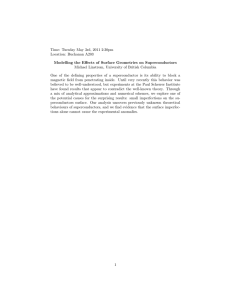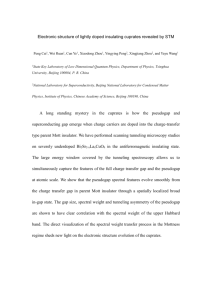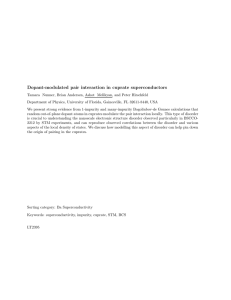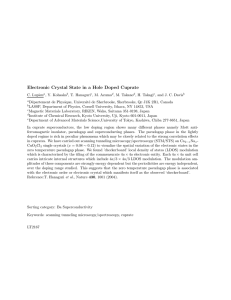Pairing, pair-breaking, and their roles in setting the Tc of
advertisement
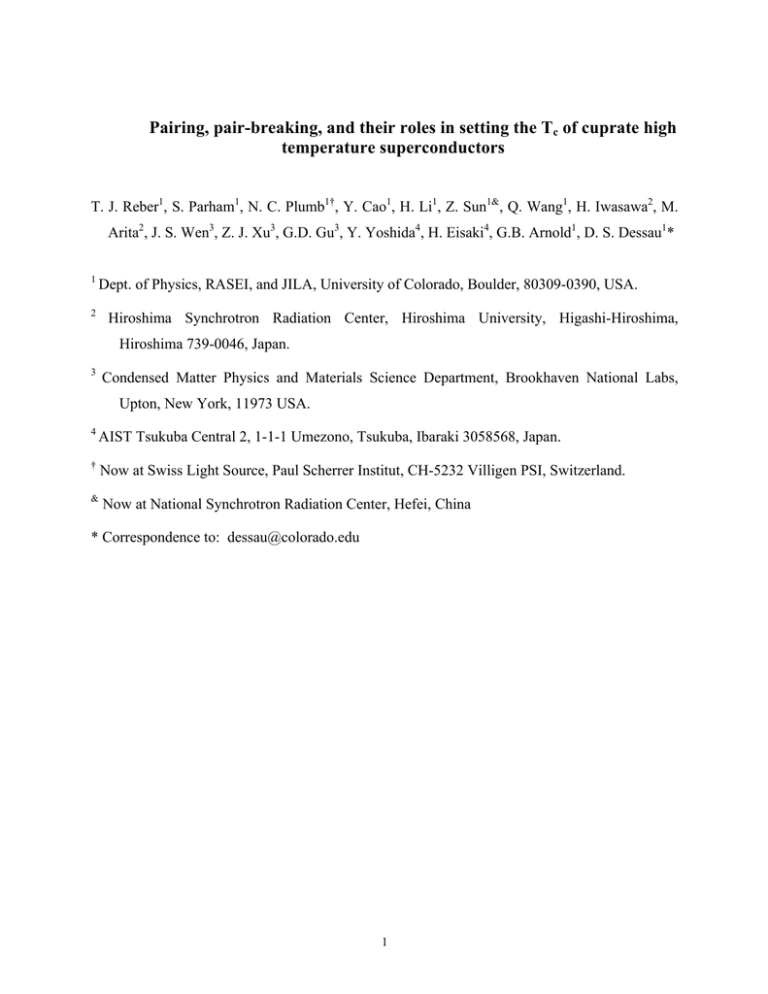
Pairing, pair-breaking, and their roles in setting the Tc of cuprate high temperature superconductors T. J. Reber1, S. Parham1, N. C. Plumb1†, Y. Cao1, H. Li1, Z. Sun1&, Q. Wang1, H. Iwasawa2, M. Arita2, J. S. Wen3, Z. J. Xu3, G.D. Gu3, Y. Yoshida4, H. Eisaki4, G.B. Arnold1, D. S. Dessau1* 1 Dept. of Physics, RASEI, and JILA, University of Colorado, Boulder, 80309-0390, USA. 2 Hiroshima Synchrotron Radiation Center, Hiroshima University, Higashi-Hiroshima, Hiroshima 739-0046, Japan. 3 Condensed Matter Physics and Materials Science Department, Brookhaven National Labs, Upton, New York, 11973 USA. 4 AIST Tsukuba Central 2, 1-1-1 Umezono, Tsukuba, Ibaraki 3058568, Japan. † Now at Swiss Light Source, Paul Scherrer Institut, CH-5232 Villigen PSI, Switzerland. & Now at National Synchrotron Radiation Center, Hefei, China * Correspondence to: dessau@colorado.edu 1 The key ingredients in any superconductor are the Cooper pairs, in which two electrons combine to form a composite boson. In all conventional superconductors the pairing strength alone sets the majority of the physical properties including the superconducting transition temperature TC. In the cuprate high temperature superconductors, no such link has yet been found between the pairing interactions and TC. Using a new variant of photoelectron spectroscopy we measure both the pair-forming (Δ) and a self energy/pair-breaking term (Γ S) as a function of sample type and sample temperature, and we make the measurements over a wide range of doping and temperatures within and outside of the pseudogap/competing order doping regimes. In all cases we find that TC is approximately set by a crossover between the pair-forming strength Δ and 3 times the self-energy term Γ s. – a new paradigm for superconductivity. In addition to departing from conventional superconductivity in which the pairing alone sets TC, these results indicate the zero-order importance of the near-nodal self-energy effects compared to competing order/pseudogap effects. 2 The macroscopic quantum state that defines a superconductor is a condensate of Cooper pairs, which are two electrons bound together to form a composite boson. With increasing temperature, thermal fluctuations get stronger and stronger, eventually overcoming the binding energy holding the pairs together (the pairing energy 2Δ). This breakup of the pairs typically sets the superconducting transition temperature TC, with the TC directly related to the strength of the pairing 2Δ. Concomitant with these ideas is a direct relation between the pairing scale and Tc, i.e. 2Δ/kTC~ 3.52 for the weak-coupling Bardeen-Cooper-Schreiffer case, with this ratio increasing to 5 or more for so-called “strong coupling” superconductors[1]. As it sets the TC of the superconductor, this pairing scale Δ effectively becomes the only relevant energy scale for the problem. In the high temperature cuprate superconductors the pairing energy is much stronger than in conventional superconductors and so it is natural that these pairs survive to much higher temperatures. Surprisingly however, it has been found that for many of the samples (especially those in the underdoped region of the phase diagram) these pairs exist even above the transition temperature (to a temperature Tpair)[2,3,4,5]. And while there is great interest in understanding the regime between Tpair and TC as well as what sets the phase coherence temperature, little direct information exists to date. A great intensity of work over the past two decades has focused on the pseudogap and the T* line of the doping phase diagram, as this was thought by many to represent a prepairing state and a precursor to the SC. Along with this, the larger gaps in the UD side suggested stronger SC pairing, though recent results indicate that these larger gaps are likely not directly related to the SC at all [6,7]. Recently, a great amount of attention has focused on CDW’s in the underdoped regime, which would most likely be a competing phase of the superconductivity [8,9]. With all of this intense work, there surprisingly has been little work looking for similarities between the under- and over-doped regimes, perhaps because it is generally thought that these two regimes are so dramatically different. Here we show that in fact critical aspects of the superconducting physics are the same for the UD and OD samples especially if we consider the electronic self-energy or scattering rate effects. Here, using a new variant of angle-resolved photoemission (ARPES) over a wide range of doping levels, we show that there is an additional key parameter that helps control the TC in these materials. We use the new TDoS (Tomographic Density of States) technique, which has 3 previously been shown to have the ability to quantitatively extract both the pairing and pairbreaking energy scales as a function of temperature [4,5]. A major advantage of the TDOS method is that it allows us to effectively remove the major impact of the heterogeneity on the ARPES spectra, giving us what is essentially the homogenous self-energy term Γs [4], which is significantly smaller than the actual linewidth of the individual ARPES spectra as these are seriously affected by the doping or chemical-potential heterogeneity (also see supplemental materials). By doing this procedure on a wide range of sample types from underdoped to overdoped and including both single and double-layer samples with drastically different TC’s, we empirically show that TC is determined by the crossover with temperature of these two energy scales. This result, which is very different from the BCS picture, connects much of the known phenomenology of the cuprates. Figure 1 shows raw TDoS data as a function of temperature from 8 different sample types, including uderdoped (UD), optimally doped (Opt) and overdoped (OD) bilayer Bi2Sr2CaCu2O8 samples with Tc values listed as the prefix of the sample name (OD75K is an overdoped sample with Tc=75K). Also included is a single-layer Bi2Sr2CuO6 sample with Tc=28K and a Ni-impurity doped Bi2Sr2CaCu2O8 sample with Tc=80K. All data were taken along a cut perpendicular to the Fermi surface that is 12 degrees away from the node (N), where the gap is zero (inset of panel e). As described elsewhere, the one-dimensional integration inherent in the TDoS analysis turns the data into k-localized density of states curves, which may then be fit by the following form first used by Dynes to fit tunneling spectra of conventional superconductors [10]. I!"#$ = Re !!!!! (!!!!! )! !∆! (1) This is essentially just a BCS density of states with pairing gap Δ broadened by the term Γs which can be equivalently looked at as the pair-breaking scattering rate or as the singleparticle electron self-energy term as described within the Nambu-Gorkov formulation of superconductivity (see supplemental materials). Fig S1 in the Supplemental Materials shows a direct comparison of the fits to all curves shown in Fig 1. Using only the two parameters of equation 1 (Δ and Γs), the fit quality is excellent in all cases. 4 While Fig 1 shows TDoS data taken at one Fermi surface angle (12 degrees), we in fact utilized and fit data from many angles for each sample. Fig S2 in the supplemental materials shows an example full set of data used on one sample, containing 6 cuts at different Fermi surface angles θFS multiplied by 10 different temperatures, giving ~ 300,000 data points total per sample. These are reduced to the specific plots of Δ and Γs vs. k for each temperature (right plots of fig S2) or vs. temperature for each k (bottom plots of fig S2), confirming the dwave nature of Δ and the near-nodal approximate k-independence of Γs for all temperatures. With this experimental knowledge of the rate at which Δ grows with Fermi surface angle θFS (often termed vΔ) we can use a simple d-wave form to extrapolate to the superconducting gap maximum ΔMax that in principle would occur at the antinode in the absence of any pseudogapping effects. Δ (θ FS ) = Δ Max sin ( 2θ FS ) (2) This value of ΔMax may be different than the gap directly measured at the antinode, and we argue that this near-nodal or vΔ gap is a more accurate way to determine the superconductive pairing scales than the direct measurement of Δ at the antinode, with the latter contaminated by the antinodal pseudogap [6,7]. The net result of doing this at each temperature is the plot of ΔMax and Γs versus T, as shown in the lower right panel of fig S2. The great many experimental data points per temperature on this sample have thus been reduced to the two key parameters (ΔMax and Γs) per temperature in this plot. A qualitatively similar temperature dependent growth has previously been extracted for optimally doped samples from STM measurements (11), our TDoS ARPES [5], and other very recent ARPES [12]. 5 Figure 2 shows a similar compilation of the data from all the fits on all the samples, each carried out in an identical way as for the optimally doped sample shown in Figs S1 and S2. In general, the magnitude of Γs found here is huge compared to the magnitude of Γs seen in other strongly coupled superconductors, either in raw numbers or when rescaled to the gap values. The left axes (ΔMax) of fig 2 have been scaled by a factor of three compared to the right axes (Γs). With this done it is seen that ΔMax and 3Γs cross very near TC for every sample, including under-doped, optimally-doped, over-doped, impurity-doped and both single and double-layer cuprates, with TC’s ranging from 28K to 91K. That this empirical finding holds over such a diversity of materials indicates that it is extremely unlikely to be a coincidence, and is likely the main ingredient for what lowers the TC of the cuprates from the onset of pairing TPair. Together with ΔMax it is apparently what sets the TC of the cuprate superconductors. Figure 3 contrasts the behavior of the cuprates uncovered here with that of a standard BCS superconductor, with the main difference being the filling in of the gap due to the pairbreaking interactions, rather than the simple BCS-like gap closing that occurs in the absence of the temperature-dependent pair-breaking. The filling in of the gap with increasing temperature is also observed in optics (13), tunneling (14), and thermodynamics (15), and thus appears to be a generic feature of the cuprates that is fully consistent with the increase of Γs with temperature that we detail here. Further, the disappearance of the “coherence peak” near and above Tc observed in earlier ARPES (16,17) and tunneling (14) experiments is also fully consistent with the rapid increase of Γs with temperature, though none of these earlier measurements were able to quantify the strength of this effect. Essentially all other main spectroscopic features observed in the cuprates are also fully consistent with our data and the schematic of figure 3b, including the findings that a) the gap energy scales stay approximately constant below TC (4, 13,14,16), b) there are prepairing fluctuations persisting for up to 30K above TC (2,5), and c) there are “Fermi arcs” in underdoped samples (18) with length increasing with temperature (19), as explained in (4). Therefore, the present result explains the general behavior of these many spectroscopies, with the new quantitative results allowing us to obtain a much greater in-depth understanding. We can intuitively understand how the competition of pairing and pair breaking sets the Tc by imagining that the pair-breaking processes at high temperatures reduce the pair lifetimes to the point that the pairs are broken almost as rapidly as they are formed.20 6 Therefore, the overall pair density just below TPair is relatively low, even though the pair binding strength (the gap energy Δ) is still rather large. As we lower the temperature towards TC the pairing strength increases slightly, but more importantly, the lifetimes of the pairs increases as seen directly by the decrease in the pair fluctuation strength Γs. At approximately the ratio Δ/Γs=3, the pairs are dense enough and long enough lived that phase coherence between them may occur. Ultimately it is this onset of long-range phase coherence that marks the onset of the critical temperature TC – that this is set approximately by the ratio Δ(Τ)/Γs(T)=3 for all doping levels is one of the major new results of this work. A dependence of Tc on the ratio of pairing and pair-breaking has been well described theoretically21, particularly in cases of induced pair-breaking through the introduction of disorder or magnetism. For example, similar physics has in fact been observed in the context of granular aluminum very near the metal-insulator transition, where localization and enhanced interaction effects become critically important, and Γs can be continuously tuned by changing the size of the aluminum grains. Tunneling measurements, analyzed using formula 1 showed that superconductivity disappears when the Γs term becomes comparable to Δ(22). Of course, the pair-breaking Γs in granular Al is a static effect, while the dynamic (temperature dependent) Γs seen in the cuprates is a more unusual and important case, and the ratio of approximately 3 in the present materials is not at the moment understood. There are two main classes of explanations for a strongly temperature-dependent Γs. A) Γs represents the large self-energy effects that are present in the normal state of the cuprates, with these being largely gapped out in the superconducting state, i.e. the superconducting state “undresses” these correlations[23,24]. In this picture these correlations are recovered as the temperature is raised towards the normal state, with these correlations being responsible for the Γs term and the filling in of the gap. B) Γs represents thermally excited excitations out of the superconducting state, for example quasiparticles across the d-wave gap edge, phonons, magnons or the magnetic resonance mode [25,26], or topological vortex excitations similar in spirit to what occurs in the Kosterlitz-Thouless transition. While more work is needed to conclusively determine the origin of the strong pair-breaking, the fact remains that the strongly temperature-dependent pair-breaking is a critical aspect of the physics, which appears to help set the TC of the cuprates. Viewed from a different angle, finding a way to minimize 7 or even remove these pair-breaking interactions points out a route towards increasing the transition temperatures of these materials, with an available temperature window for increasing the TC that is upwards of 20K. Acknowledgments: We thank A. Balatsky, E. Calleja, A. Chubukov, M. Hermele, K. McElroy, L. Radzihovsky and Xiaoqing Zhou for valuable conversations and D. H. Lu and R. G. Moore for help at SSRL. SSRL is operated by the DOE, Office of Basic Energy Sciences. ARPES experiments at the Hiroshima Synchrotron Radiation Center were performed under proposal 09-A-48. Funding for this research was provided by DOE Grant No. DE-FG02-03ER46066 (Colorado) and DE-AC0298CH10886 (Brookhaven). Author Contributions: T.J.R. And D.S.D. designed the experiment. J.S.W., Z.J.X, G.G., Y.Y., and H.E. grew and characterized the single crystal samples. T.J.R., S.P., H.L., N.C.P., Y.C., Q. W., M.A. and H.I. acquired the experimental data. T.J.R., S.P., H.L. and N.C.P. performed the data analysis. G.B.A. provided theoretical support. T.J.R. and D.S.D wrote the manuscript. All authors discussed the results and commented on the manuscript. 1"Schrieffer"J.R.""Theory"of"Superconductivity"Addison"Wesley"(1964)" 2"Dubroka, A. et al., Evidence of a Precursor Superconducting Phase at Temperatures as High as 180 K in RBa2Cu3O7-δ (R =Y; Gd; Eu) Superconducting Crystals from Infrared Spectroscopy Phys. Rev. Lett 106, 047006 (2011)" 3" Wang, Y.Y. et al. Field-enhanced diamagnetism in the pseudogap state of the cuprate Bi2Sr2CaCu2O8+d superconductor in an intense magnetic field. Phys. Rev. Lett. 95, 247002 (2005)." 4" Reber T.J. et al. The Non-Quasiparticle Nature of Fermi Arcs in Cuprate High-TC Superconductors Nature Physics 8, 606 (2012)" 5""Reber T.J. et al, Prepairing and the “filling” gap in the cuprates from the tomographic density of states Phys. Rev. B 87, 060506 (2013)" 6" Tanaka" K." et" al.," Distinct" FermiIMomentumIDependent" Energy" Gaps" in" Deeply" Underdoped"Bi2212""Science"314,"1910"(2006)" 7" Kondo, T. et al. Competition between the pseudogap and superconductivity in the high-Tc copper oxides. Nature 457, 296–300 (2009)." 8" Chang, J. et al. Direct observation of competition between superconductivity and charge density wave order in YBa2Cu3O6.67 Nature Physics 8, 871–876 (2012)" 9 Comin, R. et al. Broken translational and rotational symmetry via charge stripe order in 8 underdoped YBa2Cu3O6+y. Science 347 (2015) 1335. 10 Dynes, R. C., Narayanamurti, V. & Garno, J. P. Direct measurement of quasiparticle lifetime broadening in a strong-coupled superconductor. Phys. Rev. Lett. 41, 1509 (1978). 11 Pasupathy, A. N. et al. Electronic origin of the inhomogeneous pairing interaction in the highTc superconductor Bi2Sr2CaCu2O8+d. Science 320, 196–201 (2008). 12 Kondo T. et al, Point nodes persisting far beyond Tc in Bi2212. Nature Communications 6, 7699 (2015) 13 Basov D.N. & Timusk T., Electrodynamics of high-Tc superconductors, Reviews of Modern Physics 77, 721 (2005). 14 Fischer, O., Kugler, M., Maggio-Aprile, I., Berthod, C. & Renner, C., Scanning tunneling spectroscopy of high-temperature superconductors. Rev. Mod. Phys. 79, 353–419 (2007). 15 Tallon J.L., Barber F., Storey J. G. & Loram J. W. Coexistence of the superconducting energy gap and pseudogap above and below the transition temperature of superconducting cuprates Phys Rev B. 87, 140508(R) (2013) 16 Fedorov A.V. et.al. Temperature Dependent Photoemission Studies of Optimally Doped Bi2S2CaCu2O8 Phys. Rev. Lett. 82, 2179 (1999) 17"Feng"D.L."et"al."Signature"of"Superfluid"Density"in"the"SingleIParticle"Excitation"Spectrum" of""Bi2S2CaCu2O8 Science 289, 277 (2000)" 18" Norman M.R. et al, Destruction of the Fermi surface in underdoped high-Tc superconductors Nature 392, 157 (1998) 19 Kanigel A. et al. Evolution of the pseudogap from Fermi arcs to the nodal liquid Nature Physics 2, 447 (2006)" 20" Emery V.J. & Kivelson S. A. Importance of phase fluctuations in superconductors with small superfluid density Nature 374, 434 (1994) 21 Leggett A.J. Quantum Liquids: Bose Condensation and Cooper Pairing in Condensed-Matter Systems (2006) 22"Dynes R.C., Garno J.P., Hertel !G.B., Orlando T.P. Tunneling Study of Superconductivity near the Metal-Insulator Transition Phys. Rev Lett, 53, 2437 (1984)" 23 Hirsch, J.E. Superconductivity from hole undressing Physica C 364, 37 (2001) 24 Haslinger R. and Chubukov A.V. Condensation Energy in Strongly Coupled Superconductors, Phys. Rev. B. 67, 140504(R) (2003) 25"Fong H.F. et al. Phonon and Magnetic Neutron Scattering at 41 meV in YBa2Cu3O7 Phys. Rev. Lett. 75, 316 (1995)." 26"Hinkov V. et al., Spin dynamics in the pseudogap state of a high-temperature superconductor Nature Physics 3, 780 (2007). " 9 a)) Fig$1.$Temperature)dependent)TDoS)ARPES)data)of)Bi2Sr2CaCu2O8+d)(Bi2212))along)a)cut)12)degrees)away)from)the)node) N))(inset)of)lower)leF)panel)shows)the)cut)locaGon)in)the)Brillouin)zone).)Data)from)8)samples)are)shown,)labeled)with) their)TC)values)and)doping)types)(UD80K)=)an)underdoped)Bi2212)sample)with)Tc=80K),)Opt=opGmally)doped,) OD=overdoped.))All)samples)are)doubleQlayer)Bi2212)except)for)panel)g)which)is)singleQlayer)Bi2Sr2CuO6)(Bi2201).)Blue) curves)are)for)T<Tc)while)red)curves)are)for)T>Tc,)with)many)of)these)T>Tc)curves)sGll)showing)a)weak)gapping)effect.) The)insets)show)expanded)views)of)data)for)T)slightly)greater)than)Tc,)including)fits)to)those)data)using)equaGon)1)(black) lines)through)the)curves).) Fig$2.$A)compilaGon)of)ΔMax)(leF)axis))and)Γ)(right)axis))for)the)8)samples)shown)in)figure)1,)from)fits)to)TDoS)data) over)a)full)grid)of)many)temperatures)and)angles)(see)for)example)Fig)S1)for)a)grid)on)one)sample).))ΔMax)is)the)dQ wave)maximum)superconducGng)gap)determined)from)the)nearQnodal)data)(e.g.)vΔ))while)Γ)is)the)average)zeroQ frequency)pairQbreaking)self)energy)over)the)nearQnodal)region.)Error)bars)are)shown)in)all)cases)though)are) difficult)to)see)when)they)are)smaller)than)the)symbol)size.) BCS)) (Gap)closes)) Cuprate)) (Gap)predominantly)fills)) Δ ky kx Fig 3. Contrast between the temperature evolution of a BCS superconductor (left) and a cuprate (right). Blue=superconducting state (T<TC) while red= normal or pseudogapped state (T>TC). (a,b) With increasing temperature the BCS gap closes, reaching zero at T=TC. The pair-breaking scattering rate ΓS is in general very small and almost temperatureindependent, so it is almost always considered unimportant. (d) With increasing temperature the gap in cuprates principaly fills, which is due to the rapidly rising ΓS with temperature (panel c). The gap filling is a phenomenology observed in essentially all spectroscopies on cuprates, but has been difficult to quantify until now. Here, the superconducting transition is not marked by the gap closing to zero, but rather by a significant filling, roughly determined by the ratio ΔMax/3ΓS~1.

